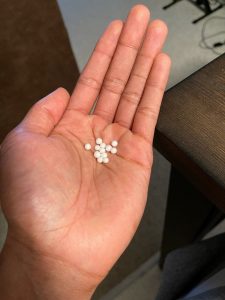

For my STEAM project, I have decided to focus on the renal system and the anatomical function of the kidneys in the human body. I created a diagram showing the anatomy of the kidneys along with the ureter, bladder, and urethra to show a completed renal system. The entire diagram was made using a few different shades of Play-Doh, two long candy sticks, a ziploc bag, and a small amount of water. Everything was put together on a poster board for display, giving a 3D-effect. The ziploc bag and water played the role of a real bladder with urine in it. I also decided to use small styrofoam balls to represent the kidney stone as well as the average size of them.

The kidneys are a pair of bean shaped organs that are located around the first three lumbar vertebrae. They are normally about 11-14 centimeters in length and weigh about 125-175 grams in males. An interesting fact about the location of the kidneys is that the right kidney is slightly lower than the left because of the displacement from the liver. (Anatomy and Physiology, 2013) Each kidney has an adrenal gland on its superior end and those are a part of the endocrine system. On the exterior part of the kidney is the dense, irregular connective tissue called the capsule. It helps keep the structure of the organ and is a protective layer to the kidney.
If we were to make a longitudinal cut on the kidney, the interior would be revealed. Deep to the capsule, you will notice the cortex, medulla, each of the separate calyces, and the renal pelvis of the kidney. The cortex is where the convoluted tubules of the nephrons are located. The Loop of Henle dips into the medulla where countercurrent exchange happens in the filtrate. You will also notice the medulla is spaced apart from each other. This formation is essential to keep the regulation of urine concentration. (Song, Yosypiv, 2012) The renal pelvis is the part of the kidney that is funnel-shaped and leads into the ureter. Its function is to provide a passageway of the drained urine through the calyces to the ureters.
An example of a disease or condition that affects the function of the kidney would be nephrolithiasis, or kidney stones. Kidney stones are mineral deposits that are formed from the oversaturation from said mineral. The most common form of kidney stones are made of calcium oxalate which are from urine being low in citrate and high in calcium. (NYULangone, 2021) The mineral deposits are small round or sharp beads that can be found attached to the renal papillae of the medulla. They become dislodged and float freely in the renal pelvis. (Khan, 2016) Once the deposit finds its way to the ureter, it can cause pain or discomfort from the jagged edges catching on the walls of the narrow ureter. This will cause the urine to contain blood. Depending on the size of the stone, it can pass through the ureter and into the bladder where it will again cause complications with urinating by lodging itself in the urethra until passing is complete.
References:
Johnson, Jody E, editor. Anatomy and Physiology, by Gordon Betts et al., OpenStax, Houston, TX, 2013, pp. 25–25.
Khan, Saeed R., et al. “Kidney Stones.” Nature Reviews Disease Primers, vol. 2, no. 1, 2016, doi:10.1038/nrdp.2016.8.
Song, Renfang, and Ihor V. Yosypiv. “Development of the Kidney Medulla.” Organogenesis, vol. 8, no. 1, 2012, pp. 10–17., doi:10.4161/org.19308.
Types of Kidney Stones. 26 Feb. 2016, nyulangone.org/conditions/kidney-stones-in-adults/types#:~:text=The%20most%20common%20type%20of,substance%20in%20plants%20and%20animals.
Eric, this is an absolutely amazing depiction of the renal system. Your description of the kidneys and their histology, as well as their functioning is very in depth and gives an exceptional overview of their processes. Moreover, the highly detailed and artistic representation of the kidneys and the bladder especially aided in understanding of the information you provide and “blew my mind”, not even joking, I wish I had a fraction of your artistic abilities. Eric utilized Styrofoam balls to represent a very prevalent condition even some of us may have had in our lives, in which I have, known as kidney stones. These extremely painful stones, as promulgated by Eric, are gathered minerals in the kidneys and move through ureter through the bladder to exit the body. Also, these stones cause blood in the urine, which is a tell-tale sign, along with their pain, of their presence. Eric’s artistic representation of this shows their passing through the renal system in their entirety and gives a prominent view of how they can drastically effect the renal system.